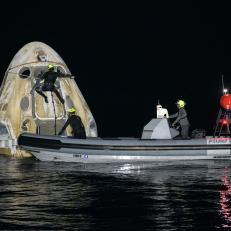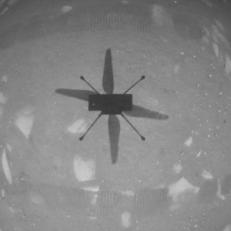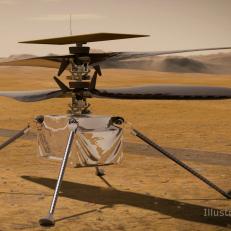Journey to the Red Planet with Perseverance and Ingenuity
(Updated: March 24, 2021)
NASA's Perseverance with Ingenuity touched down on the dusty red planet Thursday, February 18, 2021, at approximately 3:55P ET. The Mars Rover and Mars Helicopter launched on July 30, 2020, from Cape Canaveral Air Force Station in Florida. Their mission is to seek signs of ancient life and collect samples from Mars for examination on Earth. From concept to launch to its harrowing landing, here are some of the highlights and the first images sent back to Earth from the rover!
Experience more Mars on discovery+. Download and subscribe to stream NASA Mars Landing: Inside the Mission and When We Left Earth.
Ingenuity Flight Zone
The flight zone of NASA’s Ingenuity Helicopter from the perspective of NASA’s Mars 2020 Perseverance rover is seen in this image. The flight zone is the area within which the helicopter will attempt to fly.
Map of Ingenuity Flight Zone
This image on March 23, 2021, shows where NASA’s Ingenuity Mars Helicopter team will attempt its test flights. Helicopter engineers added the locations for the rover landing site, the airfield (the area where the helicopter will take off and return), and the flight zone (the area within which it will fly) on an image taken by the High Resolution Imaging Experiment (HiRISE) camera aboard NASA’s Mars Reconnaissance Orbiter.
Perseverance Rover Drops Debris Shield
The debris shield, a protective covering on the bottom of NASA’s Perseverance rover, was released on March 21, 2021. The debris shield protects the agency’s Ingenuity helicopter during landing; releasing it allows the helicopter to rotate down out of the rover’s belly.
Perseverance's First Drive on Mars
This image was captured while NASA’s Perseverance rover drove on Mars for the first time on March 4, 2021.
Perseverance Is Driving on Mars
This image was taken during the first drive of NASA’s Perseverance rover on Mars on March 4, 2021.
Navcam Panorama of the Perseverance Rover's Deck
The Navigation Cameras, or Navcams, aboard NASA’s Perseverance Mars rover captured this view of the rover’s deck on Feb. 20, 2021. This view provides a good look at PIXL (the Planetary Instrument for X-ray Lithochemistry), one of the instruments on the rover’s stowed arm.
Perseverance's Mastcam-Z
Mastcam-Z, a pair of zoomable cameras aboard NASA’s Perseverance rover, imaged its calibration target for the first time on Feb. 20, 2021, the second Martian day, or sol, of Perseverance’s mission. The Mastcam-Z team uses these targets to calibrate images of the Martian terrain to adjust for changes in brightness and dust in the atmosphere throughout the day.
Close-Up of Perseverance Parachute on the Martian Surface
The High Resolution Imaging Experiment (HiRISE) camera aboard NASA’s Mars Reconnaissance Orbiter (MRO) was able to capture this image of the final location of the parachute that helped slow down NASA’s Perseverance rover during its landing on the surface of Mars. The image was taken on Feb. 19, 2021.
Close-Up of Perseverance Descent Stage on the Martian Surface
The High Resolution Imaging Experiment (HiRISE) camera aboard NASA’s Mars Reconnaissance Orbiter (MRO) was able to capture this image of the final location of the descent stage that helped fly NASA’s Perseverance rover down to the surface of Mars. The image was taken on Feb. 19, 2021.
Close-Up of Perseverance Heat Shield on the Martian Surface
The High Resolution Imaging Experiment (HiRISE) camera aboard NASA’s Mars Reconnaissance Orbiter (MRO) was able to capture this image of the final location of the heat shield that helped protect NASA’s Perseverance rover during its landing on the surface of Mars. The image was taken on Feb. 19, 2021.
NASA’s Perseverance Rover on the Surface of Mars from the High Resolution Imaging Experiment
This first image of NASA’s Perseverance Rover on the surface of Mars from the High Resolution Imaging Experiment (HiRISE) camera aboard NASA’s Mars Reconnaissance Orbiter (MRO) shows the many parts of the Mars 2020 mission landing system that got the rover safely on the ground. The image was taken on Feb. 19, 2021.
Image of Perseverance’s Landing
This is a high-resolution still image, part of a video taken by several cameras as NASA’s Perseverance rover touched down on Mars. A camera aboard the descent stage captured this shot.
HiRISE Captured Perseverance During Descent to Mars
The descent stage holding NASA’s Perseverance rover can be seen falling through the Martian atmosphere, its parachute trailing behind, in this image taken on Feb. 18, 2021, by the High Resolution Imaging Experiment (HiRISE) camera aboard the Mars Reconnaissance Orbiter. The ancient river delta, which is the target of the Perseverance mission, can be seen entering Jezero Crater from the left.
Perseverance’s Big Wheel
This high-resolution image shows one of the six wheels aboard NASA’s Perseverance Mars rover, which landed on Feb. 18, 2021. The image was taken by one of Perseverance’s color Hazard Cameras (Hazcams).
Perseverance’s First Full-Color Look at Mars
This is the first high-resolution, color image to be sent back by the Hazard Cameras (Hazcams) on the underside of NASA’s Perseverance Mars rover after its landing on Feb. 18, 2021.
Welcome to the Jezero Crater!
Here is another photo taken by Perseverance on Mars. The rover landed at the Jezero crater.
Perseverance Has Landed on Mars!
Perseverance successfully landed on the red planet at 3:55P ET today! Here is the first photo from the rover on Mars.
Perseverance with Ingenuity Touches Down on Mars
An illustration of NASA’s Perseverance rover landing safely on Mars. As soon as the rover senses that its wheels have touched the ground, it cuts the cables connecting it to the descent stage. This frees the descent stage to fly off to make its own uncontrolled landing on the surface, a safe distance away from Perseverance.
Powered Descent for Perseverance
NASA’s Perseverance rover fires up its descent stage engines as it nears the Martian surface in this illustration. This phase of its entry, descent, and landing sequence is known as “powered descent.” The descent stage fires up its engines, flies to a reachable self-selected safe landing target, levels out, and slows to its final descent speed. It then initiates the “skycrane” maneuver: about 12 seconds before touchdown, roughly 66 feet (20 meters) above the surface, the descent stage lowers the rover on a set of cables about 21 feet (6.4 meters) long. The rover unstows its mobility system, locking its legs and wheels into landing position.
Perseverance Heat Shield Separates
In this illustration, NASA’s Perseverance rover gets its first look at the Martian surface below, after dropping its heat shield just under six minutes after entry into the Mars atmosphere. The heat shield separates about 20 seconds, and the rover is exposed to the atmosphere of Mars for the first time.
Perseverance Deploys Parachute
NASA’s Perseverance rover deploys a supersonic parachute from its aeroshell as it slows down before landing, in this artist’s illustration. The parachute, 70.5 feet (21.5 meters) in diameter, deploys about 240 seconds after entry into the Martian atmosphere, at an altitude of about 7 miles (11 kilometers) and a velocity of about 940 mph (1,512 kph). The parachute slows the vehicle to about 200 mph (320 kph).
Perseverance Guides Itself Towards the Surface
The aeroshell containing NASA’s Perseverance rover guides itself towards the Martian surface as it descends through the atmosphere in this illustration.
Perseverance Rover Decelerates in the Martian Atmosphere
In this illustration of its descent to Mars, the spacecraft containing NASA’s Perseverance rover slows down using the drag generated by its motion in the Martian atmosphere. The cruise stage separates about 10 minutes before entering into the atmosphere, leaving the aeroshell, which encloses the rover and descent stage, to make the trip to the surface. The vehicle fires small thrusters on the back shell to reorient itself and make sure the heat shield is facing forward as it plunges into the atmosphere. As it descends through the atmosphere, the spacecraft fires these thrusters on its back shell to guide itself. The spacecraft uses the Martian atmosphere to brake, causing it to heat up dramatically. Peak deceleration occurs about 10 seconds later.
Perseverance Rover’s Cruise Stage Separates
This illustration shows NASA’s Perseverance rover casting off its spacecraft’s cruise stage, minutes before entering the Martian atmosphere. Hundreds of critical events in the rover’s Entry, Descent, and Landing sequence must execute perfectly and exactly on time for the rover to touch down on Mars safely on Feb. 18, 2021. The cruise stage contains fuel tanks, solar panels, and other hardware needed during the trip to Mars. About 10 minutes before atmospheric entry, it separates from the aeroshell, which encloses the rover and descent stage. The aeroshell makes the trip to the surface on its own.
Perseverance with Ingenuity Approaching Mars
This illustration shows NASA’s Mars 2020 spacecraft carrying the Perseverance rover as it approaches Mars. Hundreds of critical events must execute perfectly and exactly on time for the rover to land on Mars safely on Feb. 18, 2021. Solar panels powering the spacecraft are visible on the cruise state at the top. The cruise stage is attached to the aeroshell, which encloses the rover and descent stage. Entry, Descent, and Landing begins when the aeroshell reaches the top of the Martian atmosphere, travelling nearly 12,500 mph (20,000 kph). It ends about seven minutes later with Perseverance stationary on the Martian surface.
Liftoff!
A United Launch Alliance Atlas V rocket with Perseverance and Ingenuity onboard launches from Space Launch Complex 41 at Cape Canaveral Air Force Station, Thursday, July 30, 2020.
We Have Liftoff of Perseverance and Ingenuity to the Red Planet!
A United Launch Alliance Atlas V 541 rocket lifts off from Space Launch Complex 41 at Cape Canaveral Air Force Station in Florida on July 30, 2020, at 7:50 a.m. EDT, carrying NASA’s Mars Perseverance rover and Ingenuity helicopter. The rover is part of NASA’s Mars Exploration Program, a long-term effort of robotic exploration of the Red Planet.
Countdown to Launch
A United Launch Alliance Atlas V rocket with NASA’s Perseverance Rover onboard is seen as it is rolled out of the Vertical Integration Facility to the launch pad at Space Launch Complex 41, Tuesday, July 28, 2020, at Cape Canaveral Air Force Station in Florida. Launch is scheduled for Thursday, July 30.
Launch Preparation
Perseverance waits to be lifted on its Atlas V launch vehicle at the Cape Canaveral Air Force Station in Florida on July 7, 2020.
Further Work on Ingenuity
Members of the NASA Mars Helicopter team, Ingenuity, attach a thermal film to the exterior of the flight model of the Mars Helicopter. The image was taken on Feb. 1, 2019, inside the Space Simulator, a 25-foot-wide vacuum chamber at NASA’s Jet Propulsion Laboratory in Pasadena, California.
Ingenuity Attached to Perseverance
An engineer works on attaching NASA's Mars Helicopter to the belly of the Mars 2020 rover — which has been flipped over for that purpose — on Aug. 27, 2019, at the Jet Propulsion Laboratory in Pasadena, California.
A Close-Up on the Lenses
This image, taken in the Spacecraft Assembly Facility's High Bay 1 at the Jet Propulsion Laboratory in Pasadena, California, on July 23, 2019, shows a close-up of the head of Mars 2020's remote sensing mast. The mast head contains the SuperCam instrument (its lens is in the large circular opening). In the gray boxes beneath mast head are the two Mastcam-Z imagers. On the exterior sides of those imagers are the rover's two navigation cameras.
Perseverance Underwent an Eye Exam
After several cameras were installed on the rover, Perseverance had an eye exam. The cameras on the rover range from wide-angle landscape ones to narrow-angle high-resolution zoom lens cameras.
The Rover’s Back Shell and Cruise Stage
A member of NASA's Mars 2020 project checks connections between the spacecraft's back shell and cruise stage. The image was taken on March 26, 2019, in the Spacecraft Assembly Facility's High Bay 1 clean room at NASA's Jet Propulsion Laboratory, in Pasadena, California.
Assembly of the Mars Rover
This image was taken on March 20, 2019, in the Spacecraft Assembly Facility’s High Bay 1 Cleanroom at NASA’s Jet Propulsion Laboratory, in Pasadena, California. Members of NASA’s Mars 2020 project install the Mars Oxygen In-Situ Resource Utilization Experiment (MOXIE) into the frame of NASA’s Mars rover. MOXIE will demonstrate a way that future explorers might produce oxygen from the Martian atmosphere for propellant and for breathing.
Artist’s Concept of Perseverance and Ingenuity on Mars
This illustration depicts Mars Helicopter Ingenuity during a test flight on Mars. Ingenuity will arrive to Mars strapped to the belly of the Perseverance rover. Ingenuity, a technology experiment, will be the first aircraft to attempt controlled flight on another planet. It is expected to attempt its first flight test in spring 2021.
What Would the Mars Rover Look Like on the Red Planet?
This artist’s concept is what the Mars rover will look like on the surface of the Red Planet. Perseverance will collect rock samples in search of habitable conditions on the dusty surface.
Artist’s Concept of Perseverance
It all begins at the drawing board. Here is a basic concept of NASA's 2020 Mars rover dated July 9, 2013. Through design, engineering, and science, Perseverance began to take shape.
























